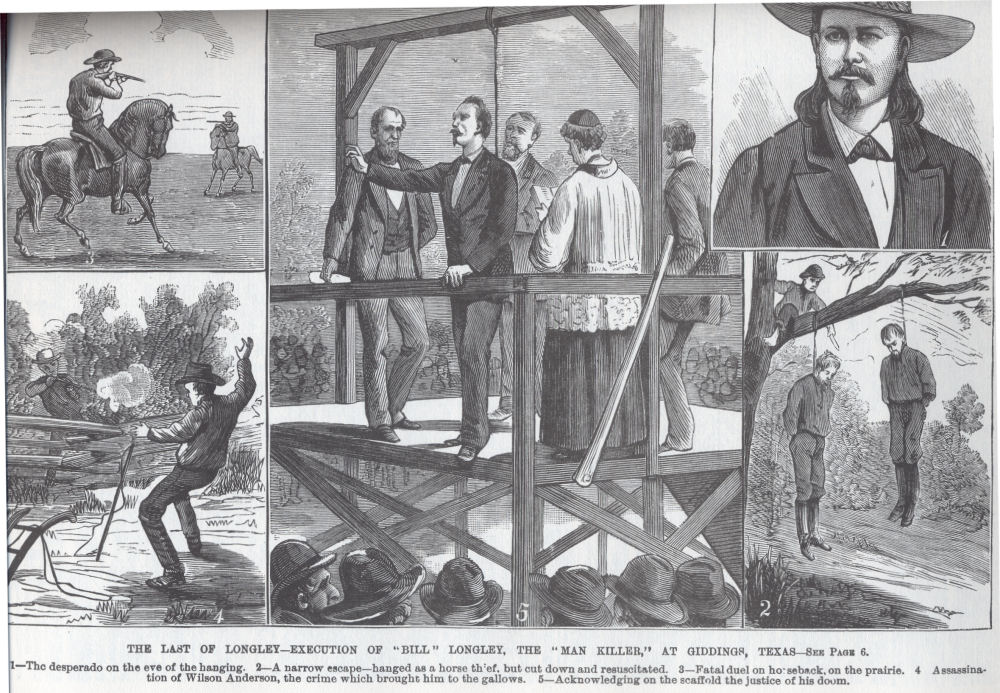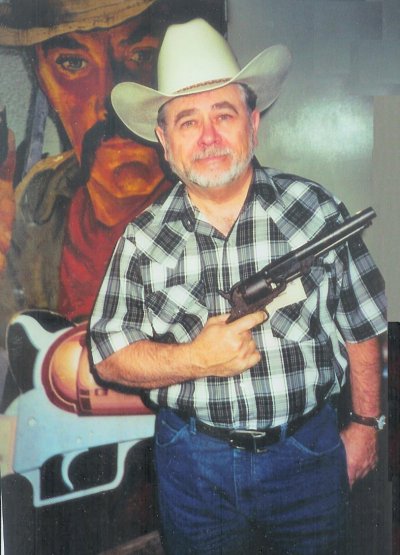Breed of the Border
BILL LONGLEY
He was a man before he was done being
a boy. That was at once Bill Longley's fate and the explanation
of this "big old He" of the long line of Texas gunmen,
for -- even more than Cullen Baker -- Longley was Number One
of the modern gunslingers.
He was a child of the Texas frontier.
Upon him environment cut like a lathe-tool. Born October 6, 1851,
on Mill Creek in Austin County, at the age of two he was taken
by that God-fearing veteran of Houston's army, Campbell Longley
his father, to Old Evergreen in Washington (now Lee) County.
He was ten when the Civil War got fully
underway. Old enough to understand the bitter feeling between
the two factions which, in Lee County as elsewhere in Texas,
were local typifications of the North and the South. Old enough
to understand the fury of the secessionists when Campbell Longley
voted the Union ticket, a rage checked before it reached the
stage of killing only by the San Jacinto record of young Bill's
quiet, determined father.
Bill Longley was always large for his
age. Six feet tall from his fifteenth year, his weight at maturity
was to be two hundred pounds so magnificently proportioned as
to make him look slender. He was the idol of the boys at Evergreen's
field schoolhouse. Dark-eyed, dark-haired, his Indian-like face
could smile or lower in the same minute. He rode like a Comanche.
He could not remember when the "hogleg" shaped butt
of the Colt's pistol was not familiar to his hard big palm.
Behind him was the background of the Texas
pioneer who had asked no odds of anything thtg ran or walked
or crept or flew. The Texan of incredible deeds, of the Alamo,
of San Jacinto. This young gamecock being bred by quiet old Campbell
Longley had in him the fiery independence of habit in thought
and action which made the Texan of the '30s onward an adventurer,
a hell-for-leather fighting an, whose suyperior has never been
seen.
He was raw material at fourteen, but destined
to be graved into what he became without much more delay, for
the South's second war began with ending of its first, a savage
guerilla war, fought never on a formal battlefield, but in a
thousand desparate, bloody skirmishes, marked by bloody cruelty
on both sides.
In Evergreen, the tiny community flanking
the Austin-Brenham road, Bill Longley was a leading spirit among
the younger generation. His size, his courage, his amazing skill
with twin Colts, a certain fierce elan which was never to desert
him, made him a marked figure among the gatherings at the crossroads
blacksmith shop and store, under the wide shade of the court
house oak -- which had served both as justice court and gallows,
in its day, and which still stands a brooding gint over that
quiet land.
The carpetbagger and the negroes were
the problems discussed at these gatherings of the disfranchised
whites. The older negroes were giving no trouble. But the younger
freed men were drunk with liberty and license. Incited to swaggering
insolence by the riffraff whites in power, protected by troops
against prosecution for any crime, they were intolerable to the
intensely proud people who were being stupidly affronted by the
worst element among their conquerors.
When a week's tale of outrages major and
minor was told, with the sullenly hopeless reflection added,
that no legal process, no orderly method, of recourse was available
to the outraged, then the human, the natural, reaction among
a people of unbroken iron temper was the impulse to hit back.
The stage was set. Bill Longley, standing
under the court house oak, with unwavering dark stare going from
one face to another, was in the grip of shaping events which
-- he proved later by his letters, he understood not at all.
All he knew was that conditions were such that no white man of
any pride of race or history could endure them. He was no philosopher,
no thinker. His brain was director of that magnificent body of
his, no tool for abstract thought.
Bill Longley . . . There are old men yet
alive who squint across the mists of a long half-century and
see him as he was in his heyday. Hunkering in the sun with back
to some corral, they mutter his name in their beards and recount
the Longley legends. He rides again, gigantic on phantom caballo,
across the blue-bonneted prairie, smoke wreathing from the muzzles
of his Colts, the elfin echo of his fierce yell carrying to us,
as once it carried thunderously into the cabins of the negroes
and sent them cowering and mumbling to the shadowed corners.
. .
He belongs to Texan folklore . . . he
stands at the head of a long procession of Texas gunmen, slingers
of the sixes who were to set style and pace for the Genus Gunfighter
elsewhere on the frontier that stretched from Montana to Mexico,
from Mississipi to California.
He is the major figure of the beginning
of the Gunman Cycle that roughly embraced the span of years between
1860 and 1900, the period in which amazing skill in the mechanics
of pistol-handling was developed, when gunplay became a be-all,
end-all, an art separate from the business of mere promiscuous
killing.
A LOUD-VOICED negro sat his norse on the
Camino Real, the ancient Royal Highway of the Spanish, which
ran from Bastrop to Nacogdoches. He was cursing certain white
men of the Evergreen neighborhood. Beyond him Bill Longley lounged
in his saddle, hands held loosely on the great horn, listening.
"And Campbell Longley," the
negro took up another name.
He cursed Bill Longley's father, but only
for a sentence. The huge sixteen-yeazr-old had moved. Down to
the curving butts of the Colts sagging at his thighs his hands
flashed. The negro saw and loud in the silence his hands slapped
the stock of the rifle across his lap.
"Don't you move that gun!" Bill
Longley snarled at him.
But the rifle lifted. Bill Longley spurred
his horse and it leaped forward, turned sideway with knee-pressure
and slight body-swaying of its rider. The rifle whanged! but
the whirling horse had carried Bill Longley clear. Back it spun
and as it straightened out into a gallop, Longley fired. The
negro came sideway, sliding out of the saddle with a bullet hole
through his head.
Sure that no second shot was needed, Bill
Longley pushed the Colts back into their holsters. He took down
the lariat from his saddle and shook out a loop. He tossed it
deftly, to encircle the dead man's neck. He dragged the body
off the road and to a shallow ditch. He buried it . . .
In the first reward that Governor James
Coke posted for Anderson's murder, Bill and James Longley were
included, but James was not in the second one. Bill wrote to
a friend that his brother James had nothing to do with the murder
of Wils Anderson.
|



 Reinterment of Bill Longley, 19 July 2001
Reinterment of Bill Longley, 19 July 2001

